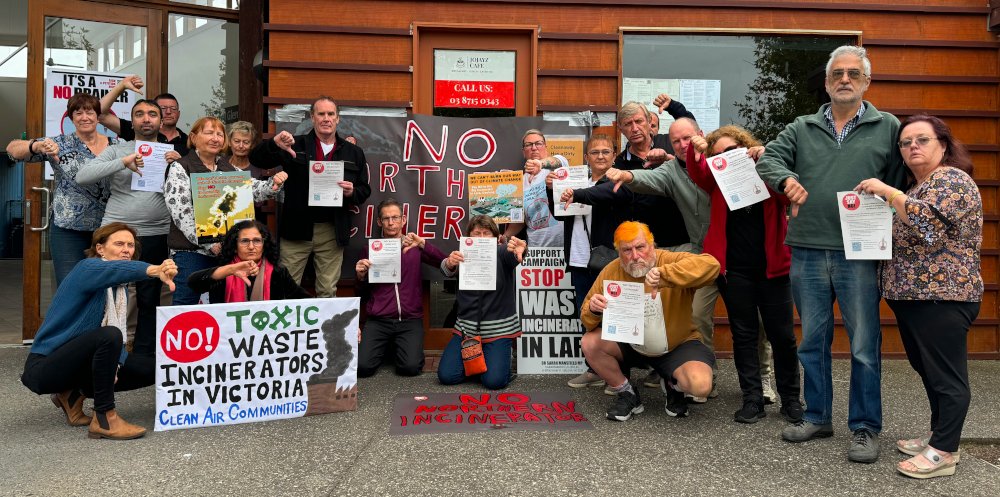
A well attended meeting at the Brookward Community Centre in Doreen heard about the dangers of waste incineration being proposed by Cleanaway in Wollert, and expedited through EPA and Planning Department processes with minimal consultation and discussion on waste incineration.
The meeting heard from Rob speaking on a campaign against a waste Incinerator in Hume, and from Jane Bremmer from Toxic Waste Australia via zoom.
A presentation by local resident Julie highlighted the local concern, given the poor outreach to communities in the north to discuss the health and environmental issues.
- Submissions needed by 14 April
- Rob on the example of the Hume Incinerator
- Jane Bremmer from Toxic Waste Australia
- Waste Incineration and Pollution under International treaties
- European Commission recommends Moratorium on new Incinerators
- Incinerator Air Pollution
- Nanoparticle Air pollution risk over long distances
- Health Impact on Children
- Health impacts, precautionary principle: Incinerators are not safe
- Risks on community agriculture and Food
- Waste to Energy is Expensive and climate polluting electricity
- Incineration incompatable with a circular Economy says UN Special Rapporteur on Toxics and Human Rights
- Locking in a waste stream maintains linear waste management
- Whittlesea Council in administration
- Merri-bek Council position
- Cleanaway Vision for Wollert
- Background
- References
Action: Submissions needed by 14 April
We need to push Julie Ahmad’s petition Say NO! To a Waste to Energy Incinerator in Wollert. Please sign if you haven’t already.
Submissions are needed for two processes (They don’t like to make it easy, do they?)
Make a submission on EPA’s development licence application
https://engage.vic.gov.au/project/cleanaway-operations-pty-ltd-app024914/survey/4430#sub-nav
Make a submission on the DTP’s planning permit application
https://engage.vic.gov.au/project/cleanaway-operations-pty-ltd-app024914/survey/4721#sub-nav
It only takes 10 minutes to put a submission into the EPA to stop the incinerator and anyone can do it. You don’t have to be a legal or technical expert .
See our previous post on 20 February 2024: Consultation on Wollert Waste to Energy Incinerator Plant. EPA engage background information.
Rob on the example of the Hume Incinerator
Excerpt of talk from the Community meeting:
I’d like to pay my respects to the Wurundjeri people on who’s unceded land we are on and thank them for their ongoing care of country.
Thanks to No Northern Incinerator – Wollert organisers for their invitation to speak here today.
I recognise the emotional, physical and mental labour that goes into supporting and organising such an important community group as this.
I’m Robert, one of the founding members of the No Toxic Incinerator for Hume community group that fought against the proposed incinerator in Craigieburn about four years ago. Thankfully we were successful in our campaign. I wish you the same success and am here to support you and provide assistance where I can.
There will, of course, be some differences in this application to what we were faced with in Craigieburn, but I hope some of the strategies we were able to put in place will be helpful to you.
The application for a waste incinerator in Craigieburn was within a couple of kilometres of residential buildings as well as schools businesses and childcare centres.
In fact, derogatively, the proposed Wollert incinerator is all but a couple of kilometres from where the Craigieburn incinerator was proposed.
In our case, the application was not made by a company that was established in waste incineration or in waste management in general.
The State governments Planning Minister bypassed the need for Hume City Council’s approval by changing the overlay on the land to negate the need for council involvement
This left us with limited avenues of addressing it with Council.
I couldn’t help notice that the State government Planning Minister has contemptuously given approvals and made changes that Cleanaway have sent out on one of their pamphlets. Which again appears to provide a streamlined, automatic approval process as long as the EPA and set guidelines for waste incinerators have been met.
We understand that the Whittlesea council is currently under administration and that will provide difficulties in lodging protests and having issues addressed by Councillors.
The spread of toxic particulates produced by this incinerator won’t simply be denoted by the smoke plume you’ll see, the dangers lie in what you don’t see!
We should be hugely concerned that this application has been made by Cleanaway. Who themselves are very proud to state that ‘they are the largest waste management company in Australia.’ Unfortunately they are very far from the best waste management company in Australia.
There have been serious concerns with their operations in the UK. There has been a consistent history of breaches, non-compliance and exposure events with their operations in Australia. There have been fines issued. Unfortunately under our current pathetic State and Federal Legislation and Regulations these fines are laughable and definitely not punitive or firmly encouraging companies to change their ways. The EPA is toothless in the face of the waste crisis.
Cleanaway’s existing poor track record does not inspire any confidence that they will manage this facility with any integrity or credibility.
We are clearly seeing a strong governmental movement towards incineration but we are not seeing any serious plan for these incinerator’s future obsolescence.
At the recent Cleanaway information session I attended, the contracted engineer to Cleanaway stated that European incinerator had an average lifetime of 30 years.
But Victoria isn’t in Europe! Just as businesses and the Victorian EPA sure as hell, doesn’t come anywhere in meeting the much vaunted EU EPA standards!
We are not seeing strong waste reduction legislation and policies from either Labor or Liberal parties.
Nor are we are seeing any serious legislation, policies, strategies or growth within the recycling industry. And we sure aren’t seeing any dramatic increases in industry recycling capacities.
What we are seeing is a drastic increase in the number of incinerators throughout Victoria and increase in accumulative toxic discharges and toxic waste.
So in 10, 20, even 30 years, who will be held accountable for the cost on our communities, the risks and impacts that these facilities pose. I can’t help but think and reflect on the way James Hardy adhered to its Corporate Social Responsibility when it was dealing with the whole asbestos issues – NOT.
There’s only two things that Labor and Liberal politicians know: money and hubris. Whilst business will take care of the money, I strongly urge you to confront the politician’s hubris.
Email your state politician and tell them their obsession with these toxic incinerators as a means of magically fixing Victoria’s waste problem will cost them your vote at the next state election.
Take the time, if you can, to talk to every residents association, community and sporting groups, religious organisations, schools, childcare centres and local businesses.
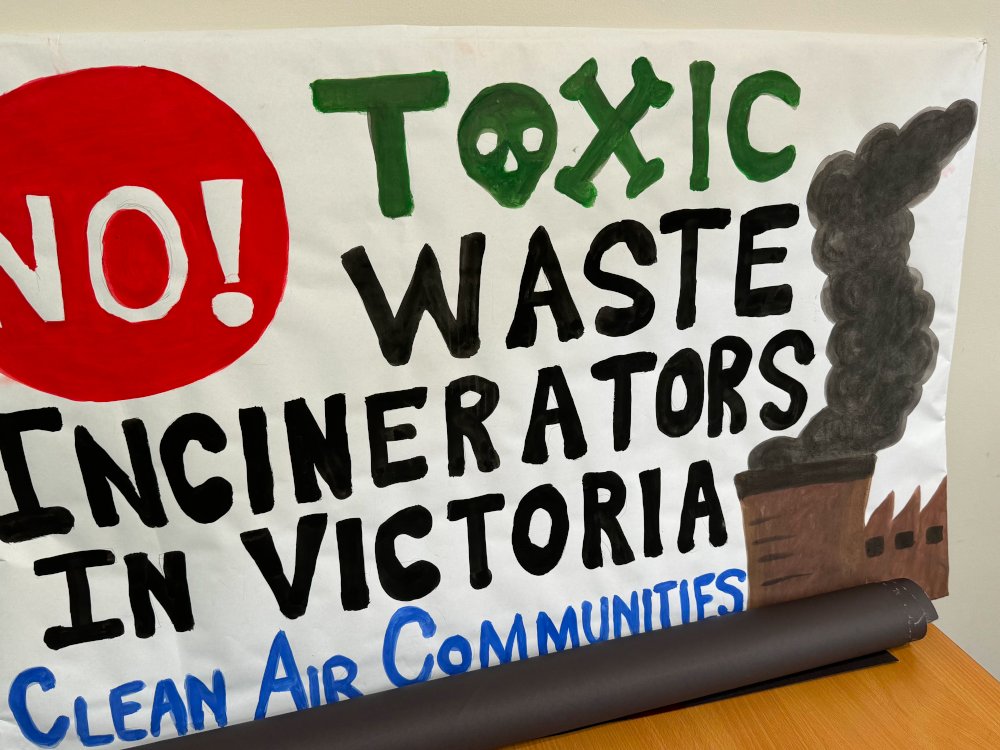
Jane Bremmer from Toxic Waste Australia
Jane Bremmer is based in Western Australia (WA) and has worked for environmental health and justice for more than 20 years. Currently leading the Zero Waste Australia campaign, Jane works collaboratively with local, state, national and international ngo’s, experts and researchers to resist incinerators and establish zero waste city models. As a core member of the Break Free from Plastic movement and long term member of the Global Alliance for Incinerator Alternatives, Jane works to address the systemic failures driving the global waste and plastic pollution crisis.
With a strong background in toxics disputes and environmental justice, grounded in her own
personal experience living next to ‘WA’s worst toxic site’, Jane works to empower communities to defend their human rights to clean air, water and soil through the principles of ‘community right to know’ and access to independent science and expertise.
As such, Jane is also a member of, the International Pollutants Elimination Network (IPEN) representing more than 700 public interest groups – working for a toxics free future at the highest level with the International Stockholm, Rotterdam and Basel conventions.
Jane coordinates a number of Western Australian local environmental health and justice groups working on air quality protection, toxics, waste management, pesticides and contaminated sites. This work resulted in the establishment of WA’s first ever Contaminated Sites Act. Jane has also served 10 years on the Australian National Industrial Chemicals Notification and Assessment Scheme (NICNAS) Community Engagement Forum, where major reforms were achieved to assess the large backlog of ‘existing chemicals’ in use in Australia that have not been assessed for human health or environmental impacts.
The protection of children’s health especially is Jane’s key motivation and underpins all her work. She was awarded the Sunday Times Pride of Australia Medal for environmental activism 2007.
Jane Bremmer joined us on Zoom with the meeting recorded.
0:00 Introduction
3:30 Technical glitch
7:30 Rob from Hume Campaign (2020)
13:50 Jane Bremmer (JB) presentation Intro
20:35 JB on Zero Waste Australia and context
21:31 JB on Australia Waste Export Ban
23:30 JB on $7.8 billion investment in two plants
24:03 JB on the three International Conventions covering waste Incineration
26:29 JB on Europe direction with waste incinerators
27:52 JB on Mass Combustion Incinerator design
28:56 JB JB on Air Emissions
29:10 JB on Nano particulate pollution
30:10 JB on Impacts on Children
31:25 JB on high toxic ash
32:26 JB on PFAS and microplastics in air pollution and fly ash
32:50 JB on Health studies and Industry greenwash
34:12 JB on impacts on agriculture, locally grown food, threat of dioxins
35:30 JB on Image projection of clean operation
35:50 JB on Incinerator expensive and high carbon polluting
38:00 JB Incinerators have no social licence to operate
38:17 JB on UN Special Rapporteur on Toxics and Human Rights report
39:00 JB on the Solutions for a Circular Economy
40:20 JB on Toxics Elimination
41:05 Tess introduces Petition and local film
42:00 Local Film Intro
45:08 Wollert Incinerator Film
48:40 Cath on EPA Process and writing submissions
53:00 Questions
1:00:10 Question on Air Pollution
1:00:58 JB on Cleanaway, State Gov legislating Waste to Energy. Incredible powers given to head of Recycling Victoria
1:05:27 Tess on next steps
Waste Incineration and Pollution under International treaties
As Waste Incineration plants produce air pollution and toxic ash pollution, they are covered and need to be regulated in accordance with International Treaties that includes the Stockholm Convention, Minamata Convention, and Basel Convention.
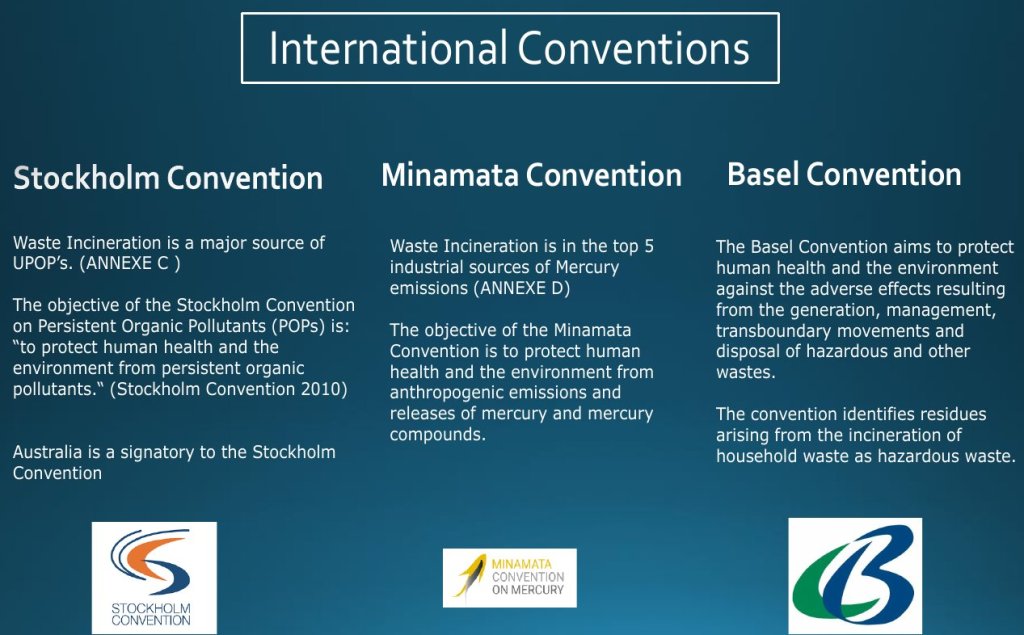
The question needs to be asked, Why are there no Environmental Impact Assessment
requirements for Victorian Incinerator projects? We just get an EPA assessment with no independant environmental or health impacts assessment. Yet the Basel Convention states clearly that an environmental assessment should be undertaken.
Under Paragraph 50, of the Basel Convention Technical Guidelines on Incineration on land as revised in 2022 (D10 and R1) (See PDF) says cleary an environment impact assessment for a site is required.
Basel Convention, Technical guidelines on the environmentally sound incineration of hazardous wastes and other wastes as covered by disposal operations D10 and R1 (2022)
- For potential sites, an environmental impact assessment should be done to determine the environmental impacts and the environmental technical, legal, social and economic feasibility of establishing a facility.

Yet the Minister for Planning rejected the need for a full Environmental Effects Statement on 5 October 2023 saying air pollution and greenhouse gas are unlikely to be significant or can be managed under existing processes. There is no supporting evidence provided to justify this..

European Commission recommends Moratorium on new Incinerators
Slide 9 on a 2017 European recommendation on Waste to Energy is particularly interesting. Why is Victoria scaling up Waste to Energy Incineration when Europe is talking about moratoriums on new incinerators and decommissioning existing polluting incinerators?

You can read the European Commission communication on Waste to Energy from 2017.
Incinerator Air Pollution
Slide 12 details Incinerator air emissions:
- oxides of nitrogen (NOx)
- carbon monoxide (CO)
- sulfur dioxide (SO2)
- particulates (TSP, PM10, PM2.5 and nano-particles),
- volatile metals (As, Sb, Co, Cr, Cu, Pb, Mn, Ni, V)
- Mercury and cadmium
- acid gases (HCl, HF and SO2)
- volatile organic compounds (VOCs),
- polycyclic aromatic hydrocarbons (PAHs),
- dioxins and furans.
Nanoparticle Air pollution risk over long distances
Slides 13 and 14 detail the danger of nanoparticles. That Nanoparticles are
not efficiently captured by air pollution control devices, travel long distances,
penetrate deep into the lungs. Nanoparticles from incinerators contain:
- neurotoxic metals,
- stabilized free radicals
- thousands of newly synthesized compounds (including PCBs, dioxins and furans).
- Any toxic element used in commerce has the potential to end up in nanoparticles produced by incinerators
Health Impact on Children
Slide 15 highlights that pollution impact on chidren and their development is fundamentally different to impacts on adults. This includes:
- Chemicals interrupt fundamental windows of development, causing long term impacts.
- Children inhale, ingest and absorb more pollution than adults.
- Children’s toxic elimination processes are undeveloped.
- Chemical body burdens are increasing by generation.
- Our children (including in-utero) are the most vulnerable.
Health impacts, precautionary principle: Incinerators are not safe
Slide 19 has a quote from the Public Health Association about the health safety of incineration. This comes from a peer reviewed science article in the Australian and New Zealand Journal of Public Health, Volume 44, Issue 1, February 2020, Pages 40-48, The health impacts of waste incineration: a systematic review. Worth reading the articles conclusion in full:
This is the first systematic review that links the literature on exposure assessments (internal and external toxin measurements) to health outcomes. While we recognise that all studies discovered had limitations (only five reached NHMRC criterion C), this review permits assessment of incinerator safety.
This review shows contamination of food and ingestion of pollutants is a significant risk pathway for both nearby and distant residents. While occupationally exposed groups have been shown in primary studies to most likely suffer adverse effects, they are a relatively smaller population than all residents in the vicinity of incinerators. Workers may be considered a sentinel population for adverse effects. Incinerator workers are probably also local residents so also subject to exposures outside the workplace. Both local residents ingesting food grown in close proximity to incinerators, as well as more distant populations consuming food transported from areas near an incinerator, are open to exposure. Because most studies in this review examined only a small subset of potential exposure and disease pathways, together with the low quality, it is likely that our review has ‘under‐discovered’ the full health‐effects picture.
This systematic review highlights significant risks associated with waste incineration as a form of waste management. Many older incinerators were linked with neoplasia, reproductive issues and other diseases. While the results were not consistent across the literature, based on a precautionary principle there is insufficient evidence to conclude that any incinerator is safe. There is some suggestion that newer incinerator technologies with robust maintenance schedules may be less harmful, but diseases from exposures tend to manifest only after many years of cumulative exposure, so it is premature to conclude that these newer technologies improve safety.
Incineration for waste management, including waste‐to‐energy options, is likely to remain an alternative that governments will consider. However, the financial and ecological costs of waste to energy are comparably high. Building reliance on a waste stream for energy counters the need to reduce waste overall. This review suggests that incineration is not without problems and so it is an option that needs to be pursued carefully with close monitoring. Local community groups have a basis for legitimate concern and so siting of incineration facilities needs to take these concerns into account. Early transparent consultation with communities about these facilities is essential.
Peter W. Tait et al, The health impacts of waste incineration: a systematic review (February 2020), Australian and New Zealand Journal of Public Health,
The researchers recommended that:
- Since there has been insufficient time for health effects of newer technology to emerge, a precautionary approach to licensing and monitoring incinerators must continue.
- As a condition of applying for a licence to build waste incinerators, independent third-party conducted baseline population studies and long-term surveillance cohort studies be mandated to measure the longitudinal and emerging effects of the incinerator’s presence on the local community and the environment.
- Health and safety standards for workers should be enshrined in law and should include regular health checks and exposure monitoring.
- In countries that have ratified the Stockholm Convention (Australia has), incinerators should be designed to meet the Convention guidelines.
- Facility upgrades and regular maintenance schedules for incinerators must be adhered to.
- New incinerators should be located away from areas of food production.
- Food grown near an incinerator should be avoided.
Risks on community agriculture and Food
Slides 22, 23, 24 highlight the risks of dioxin, PFAS and other pollution on locally grown food in Switzerland and France. Nano particulate emissions from an Incinerator plant at Wollert could poison locally grown food and eggs, adding to the cumulative health impact of residents. Even the best flue gas filters will have trouble preventing nano particulate pollution. Due to their very small size these get taken up in plants, by chickens, and ingested by humans deep into our lungs adding to cumulative health impacts that may only be discernable years later.
See EuroNews Green article, November 2023: Millions in France warned not to eat eggs from backyard chickens due to forever chemical pollution, The warning not to eat backyard eggs now covers the entire Ile de France Paris region due to PFAS and dioxin contamination threat. The contamination has been linked to waste incineration plants.
Mixed agriculture still occurrs around Wollert, not to mention backyard chickens and veggie plots in surrounding residential areas. But even Community gardens in Merri-bek such as CERES and Fawkner Food Bowls may be subject to air pollution contamination.
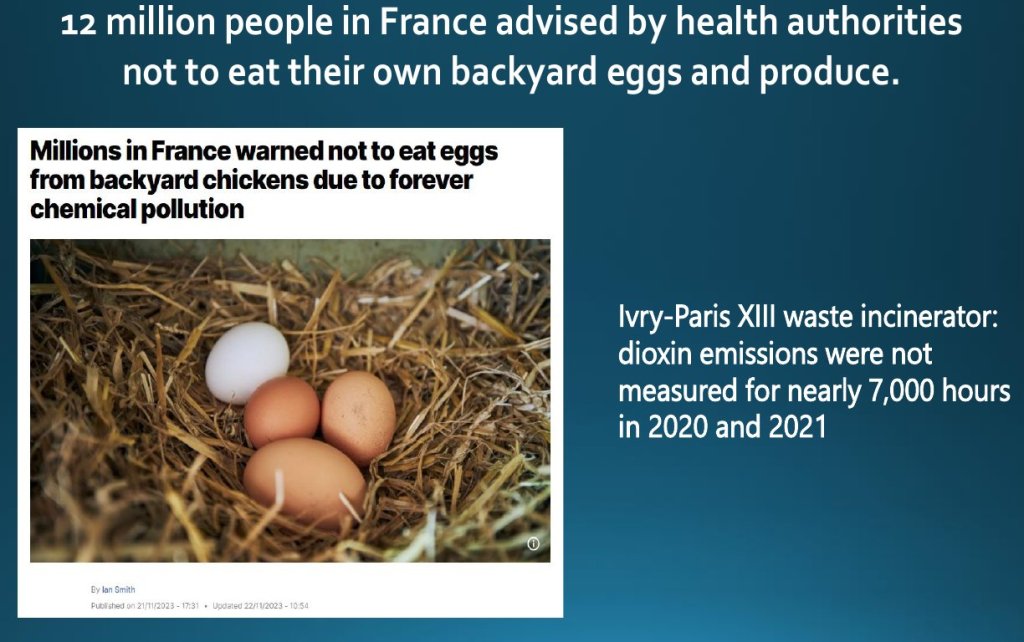
Waste to Energy is Expensive and climate polluting electricity
Slides 27 and 28 argue that Waste to Energy is a very expensive way to produce electricity and also produces a high level of greenhouse gases adding to climate pollution. It is a linear waste disposal process that does not work well within a circular economy framework.
A June 2023 USA study found that
“incinerators emit more greenhouse gas emissions per unit of electricity produced (1707 g CO2e/kWh) than any other power source (range: 2.4 to 991.1 g CO2e/kWh). They also emit more criteria air pollutants than replacement sources of energy, such as natural gas. Incineration’s inclusion in “renewable” or “clean” energy standards is thus counterproductive, as they also divert more than $40 million in subsidies annually from cleaner energy sources. As the electric grid decarbonizes, these disparities will only grow. “
Tangri N (June 2023) Waste incinerators undermine clean energy goals. PLOS Clim 2(6): e0000100. https://doi.org/10.1371/journal.pclm.0000100

A Zero Waste European policy briefing report in September 2019 – The impact of Waste-to-Energy incineration on climate – examined the data and found more fossil fuel carbon emissions from waste incineration than from gas. It concluded that:
“European incinerators generate a significant amount of direct CO2 emissions (580g CO2eq/kWh), which is twice the current EU28 average electricity grid intensity (298g CO2eq per kWh) and significantly greater than energy produced through conventional fossil fuel sources such as gas.”
Zero Waste Europe, (September 2019) The impact of Waste-to-Energy incineration on climate
The Eunomia report, January 2022, modelled greenhouse gas emissions from different sources of power, including coal, CCGT, nuclear, solar, wind, and incineration. While Waste to Energy produces less emissions than coal fired power in the Australian context, it is greater than all other forms of electricity generation. Keep in mind that Incineration with CHP (district heating) as is often used in Europe is not used here in Australia.
In a rapidly decarbonising electricity sector, Waste to Energy carbon pollution intensity becomes problematic for Victoria’s net zero climate target in 2045.
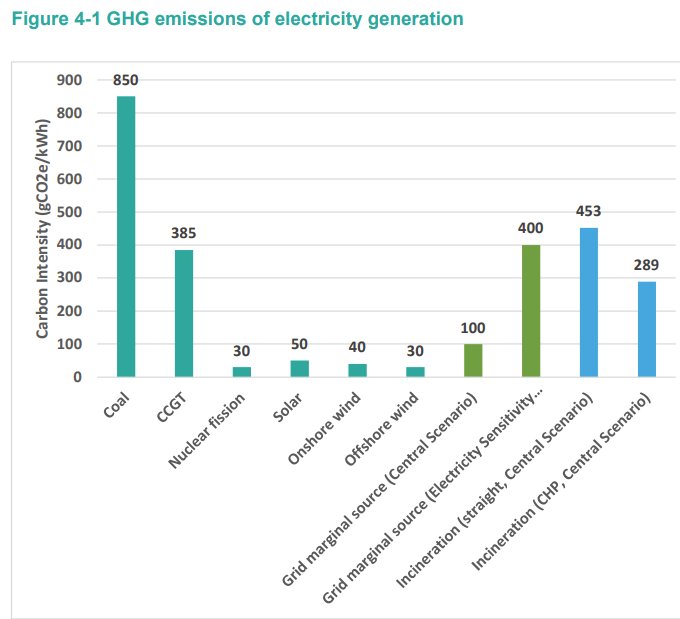
“Incineration cannot be considered a ‘green’ or low carbon source of electricity, as the emissions per kWh of energy produced are higher than CCGT, renewables, and the likely aggregated future marginal source of electricity in Australia. The carbon intensity deficit of residual waste incinerators will increase as the electricity grid decarbonises. The use of incineration is therefore also incompatible with the achievement of local net zero climate change targets in respect of emissions from energy generation, unless coupled with carbon capture and storage. This technology is not yet commercially viable, and its use will considerably increase the cost of waste treatment.”
Eunomia report, January 2022
Landfill is not without issues of greenhouse gas pollution, and requires pre treatment including separation of biological waste for recycling, and constant gas recovery to minimise emissions.
Landfill with full pre-treatment (Zero Waste policies) provide the best option for Australia’s residual waste in terms of climate, air quality and public health costs.
For reduced air pollution impacts and economic cost landfill with bio-stabilisation makes the most economic and health sense for waste management as part of a circular economy.
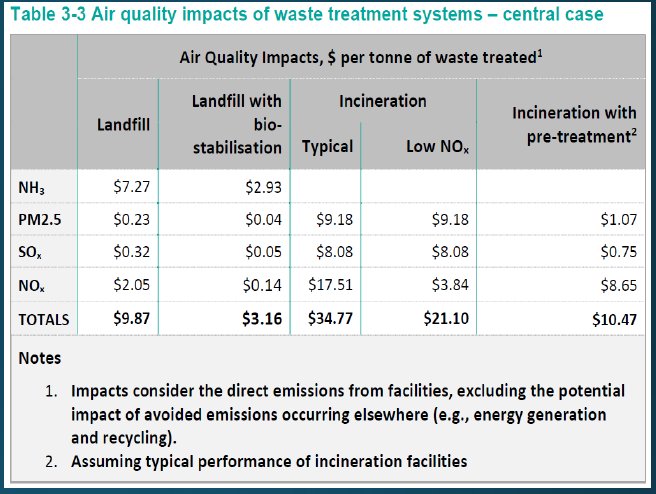
Source: Eunomia report, January 2022, Greenhouse Gas and Air Quality Impacts of Incineration and Landfill
Incineration incompatable with a circular Economy says UN Special Rapporteur on Toxics and Human Rights
Marcos A. Orellana, UN Special Rapporteur on Toxics and Human Rights, visited Australia from 28 August to 8 September 2023. In his End of Mission Statement released 8 September one of the areas he highlighted was Waste Incineration. Here is what he said on Waste Incineration:
Waste incineration is the end of the line for fossil fuels. It reflects a linear process that is incompatible with a circular economy. Incineration imposes heavy health and other costs on local communities, and it is a significant source of greenhouse gases. It has been reported that even the most modern incinerators produce dioxins, furans and toxic ash.
The case of Tarago in New South Wales, where a waste incinerator has been proposed, is instructive on the potential health, agricultural and economic impacts. Tarago produces significant amounts of food for the State. Reportedly, the government has decided not to site incinerators in Sydney, and instead to site them in four regions, including Tarago. I heard from residents that they had not received adequate explanations for this decision, that it had been taken without consultations, and that they felt treated as second-class citizens, condemned to suffer the environmental injustice of disproportionate toxic impacts.
Marcos A. Orellana, UN Special Rapporteur on Toxics and Human Rights, UN Press Release
Locking in a waste stream maintains linear waste management
One of the issues with a Waste to Energy Incinerator is the facility needs to lock in a waste stream through contracts. This can mean items in that waste stream that could be diverted for recycling as part of the circular economy are instead incinerated. This locks in the inefficiency and carbon intensity of waste incineration instead of pursuing circular economy solutions. These facilities are built to operate for 30 years. Victoria has set 2045 as a net zero target in legislation. Waste Incinerators become stranded assets in a net zero economy.
Whittlesea Council in administration
The community meeting noted that the proposal is located in Whittlesea municipality with Council under administration. The Victorian government dismissed Whittlesea Council on 20 March 2020 and replaced them with three administrators who will govern for four years.Therefore, there is no local council engagement, representation of residents, or input to the EPA and Planning processes. While Councils are established under the Local Government Act, they can provide an essential means for local discussion of controversial developments. Residents have been denied this essential opportunity and human rights for discussion at the local government level.
Merri-bek Council
Merri-bek Council already has a policy on opposing Waste to Energy Incineration. Cr Sue Bolton has proposed a reaffirmation of this policy and for Council to do a submission for the Council meeting 10 April.
The Present Merri-bek Council policy: Waste and Litter Strategy 2018 PDF link
4.6.3 Waste to Energy
Council will actively evaluate the potential benefits of regional contracting for garbage services and for the transition to Advanced Waste and Resource Recovery Technologies when the costing is competitive and landfill contracts conclude. In line with the objectives of the waste hierarchy and principles of a circular economy Council will support the regional development of non-thermal technologies such as anaerobic digestion and in-vessel composting where the outputs produced can be captured and used. Council will not support the development of thermal ‘waste to energy’ technologies such as incineration, gasification, combustion, pyrolysis and plasma arc for the disposal and treatment of waste. Thermal technologies can produce a host of negative environmental impacts including release of toxins into the atmosphere. Such an approach does not align with the goal of creating a regenerative and sustainable system for resource use. Council will instead support the development of technologies that do not create further environmental harm or undermine efforts to recover and recycle materials.
Merri-bek Waste and Litter Strategy 2018
Motion for 10 April 2024 Council Meeting:
8.4 NO TO WASTE TO ENERGY INCINERATOR IN NORTHERN SUBURBS
Cr Sue Bolton
Motion: That Council:
- Reaffirms its opposition to Waste to Energy incineration.
- Make a submission in response to the proposed Wollert Waste to Energy facility
indicating Merri-bek Council’s opposition to thermal waste to energy technologies. - Ensure that future Merri-bek waste processing contracts prohibit waste to energy
thermal technologies.
The motion was passed unanimously with Council meeting on 11 April 2024.
Before the vote, a Councillor asked for information through the mayor if Council staff could prepare a submission in the short time frame available. The Director replied that staff were available and given the work done on waste management and circular economy, had information on hand to inform a rapid submission.
Cleanaway vision for Wollert
The Australian Financial Review did a bit of a puff piece on reducing waste, including Cleanaway’s vision for MERC at Wollert. They described waste to Energy incineration without mentioning any of the environmental and health impacts. Mark Schubert is Cleanaway’s CEO. Here is an excerpt:
Schubert’s vision for the wide open Wollert site? An industrial park with Cleanaway facilities and third-party tenants buying “behind-the-meter” baseload power and saving themselves substantial transmission and distribution costs.
The steam can also supply direct heat or – when inverted – cooling. He muses about putting a battery next to the generator to “play with the shape” – shift the power around to maximise returns – and feeding waste CO₂ to “protected cropping” in closed hydroponic and greenhouse crops.
“Just imagine a precinct that sits around that thing that is local jobs – local industrial jobs – enabled or accelerated by an energy from waste facility that, really, you don’t even know what goes on inside the shed,” he says.
Australian Financial Review, 8 Jan 2024
So, feeding CO2 to ‘protected cropping’ while local residents veggie gardens, and farmers feel the fallout of toxic air pollutants! Remember, ultrafine particles and gases are unable to be completely filtered out even with the best air pollution filters and will be released.
Background Resources
there’s lots of great questions: Questions to ask when faced with a Waste to Energy proposal (GAIA 2016)
These links may help too
- Link – Zero Waste Australia – huge range of online resources & links
- Link – NTN – 10 reasons why burning waste for energy is a bad idea
- Link – National Toxic Network webinar – Threat of Incineration
- Link – NTN – Eunomia Report: Greenhouse Gas And Air Quality Impacts Of Incineration And Landfill
- Link – No More Incinerators: Say no to Suez’s Matraville Incinerator
– Bayside & Randwick City council supported the community to fight this project and WON! - Link – The Greens Facts Sheet: Waste To Energy: Greenwash At Its Best
- Link – Vic Greens video on incineration
- Link – No toxic incinerator for Victoria Fb site
- Link – OS – explainer video on incinerators – MUST WATCH 4 mins
- Link – Monash Uni for CHO: Literature review and report on the potential health effects of Perfluoroalkyl compounds, mainly Perfluorooctane Sulfonate (PFOS)
- Link – Euronews: Zero Waste Europe: Hidden emissions Netherlands case study
- Link: Burning questions remain over Europe’s waste incinerators
- Link – Euronews: Millions in France warned not to eat eggs from backyard chickens due to forever chemical pollution – https://www.euronews.com/green/2023/11/21/millions-in-france-warned-not-to-eat-eggs-from-backyard-chickens-due-to-forever-chemical-p
- Link – Ivry-Paris XIII waste incinerator: dioxin emissions were not measured for nearly 7,000 hours in 2020 and 2021
- Link – Health study Dr Peter Tait et al, The health impacts of waste incineration: a systematic review – most important systemic review of health impacts of incineration
- Link – Guardian – How bad is air pollution in Australia? Search for your postcode on our interactive map
- Link – Guardian explainer: Air pollution: how bad is particulate matter for your health?
- Link – Guardian: Australia’s air pollution hotspots hit disadvantaged people harder
- Link – Centre for Air pollution, energy and health research: Patterns of Air Quality around Australia
- Link – Incineration and Human Health State Of Knowledge Of The Impacts Of Waste Incinerators on Human Health, Michelle Allsopp, Pat Costner And Paul Johnston, Greenpeace Research Laboratories, University Of Exeter, UK or link here
References
Engage Victoria – EPA Victoria, 20 February 2024, Cleanaway Operations Pty Ltd (APP024914) https://engage.vic.gov.au/cleanaway-operations-pty-ltd-app024914
Climate Action Merribek, 20 February 2024, Consultation on Wollert Waste to Energy Incinerator Plant.https://climateactionmerribek.org/2024/02/20/consultation-on-wollert-waste-to-energy-plant/
See Zero Waste Australia list of Facsheets associated with Waste Incineration, https://zerowasteaustralia.org/publications/
Julie Ahmad’s petition Say NO! To a Waste to Energy Incinerator in Wollert https://www.change.org/p/say-no-to-a-waste-to-energy-incinerator-in-wollert
Youtube, 7 April 2024, Wollert Waste Incinerator Community meeting 2024 04 06 https://www.youtube.com/watch?v=o0zbuk5BnAs
Jane Bremmer presentation to Community meeting, 6 April 2024, https://climateactionmerribek.files.wordpress.com/2024/04/wollert-w2e-presentation-6th-april-2024.pdf
European Commission communication on The role of waste-to-energy in the circular economy, (26 January 2017), https://eur-lex.europa.eu/LexUriServ/LexUriServ.do?uri=COM:2017:0034:FIN:EN:PDF
Peter W. Tait et al, The health impacts of waste incineration: a systematic review (February 2020), Australian and New Zealand Journal of Public Health, https://www.sciencedirect.com/science/article/pii/S132602002300732X
Tangri N (June 2023) Waste incinerators undermine clean energy goals. PLOS Clim 2(6): e0000100. https://doi.org/10.1371/journal.pclm.0000100
Zero Waste Europe, (September 2019) The impact of Waste-to-Energy incineration on climate, https://zerowasteeurope.eu/wp-content/uploads/edd/2019/09/ZWE_Policy-briefing_The-impact-of-Waste-to-Energy-incineration-on-Climate.pdf
Eunomia report, January 2022, Greenhouse Gas and Air Quality Impacts of Incineration and Landfill, https://ntn.org.au/wp-content/uploads/2022/04/Greenhouse-Gas-and-Air-Quality-Impacts-of-Incineration-and-Landfill-v2.2-clean.pdf
Marcos A. Orellana, UN Special Rapporteur on Toxics and Human Rights, visited Australia from 28 August to 8 September 2023. End of Mission Statement released 8 September available via UN News: Australia: Deep divide between Government and community narratives on toxics fuels anger and distrust, says UN expert https://www.ohchr.org/en/press-releases/2023/09/australia-deep-divide-between-government-and-community-narratives-toxics
Merri-bek Council policy: Waste and Litter Strategy (2018), https://www.merri-bek.vic.gov.au/globalassets/key-docs/policy-strategy-plan/waste-and-litter-strategy-2018—2022—version-for-web-pdf.pdf
Environment Justice Australia (EJA) Media release July 21, 2023, Chemical cocktail: Lara waste-to-energy facility proposal is on the nose https://envirojustice.org.au/press-release/chemical-cocktail-lara-waste-to-energy-facility-proposal-is-on-the-nose
Ben Potter, Australian Financial Review, 8 January, 2024, Five ways to get Australia’s waste problem under control https://www.afr.com/policy/energy-and-climate/five-ways-to-get-australia-s-waste-problem-under-control-20231108-p5eikh
Peter Smith, EuroNews Green, 21 November 2023, Millions in France warned not to eat eggs from backyard chickens due to forever chemical pollution, https://www.euronews.com/green/2023/11/21/millions-in-france-warned-not-to-eat-eggs-from-backyard-chickens-due-to-forever-chemical-p
Victoria Planning Department, Melbourne Energy Resource Centre, Ministers decision on referral for an Environment Effects statement, 5 October, 2023, https://www.planning.vic.gov.au/environmental-assessments/browse-projects/referrals/melbourne-energy-resource-centre
Basel Convention, Technical guidelines on the environmentally sound incineration of hazardous wastes and other wastes as covered by disposal operations D10 and R1. https://www.basel.int/TheConvention/OpenendedWorkingGroup(OEWG)/Meetings/OEWG12/Overview/tabid/8264/ctl/Download/mid/25447/Default.aspx?id=15&ObjID=25696
Note: At its fifteenth meeting (COP15) of the Basel Convention, by its decision BC-15/8, the COP adopted revised versions of technical guidelines regarding Incinerators.